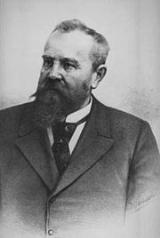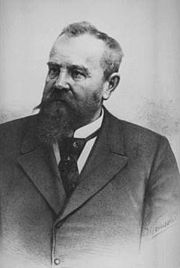
Eduard von Hofmann
Encyclopedia

Prague
Prague is the capital and largest city of the Czech Republic. Situated in the north-west of the country on the Vltava river, the city is home to about 1.3 million people, while its metropolitan area is estimated to have a population of over 2.3 million...
. He was a pioneer of modern forensic pathology
Forensic pathology
Forensic pathology is a branch of pathology concerned with determining the cause of death by examination of a corpse. The autopsy is performed by the pathologist at the request of a coroner or medical examiner usually during the investigation of criminal law cases and civil law cases in some...
.
In 1861 he earned his medical doctorate at Charles University in Prague
Charles University in Prague
Charles University in Prague is the oldest and largest university in the Czech Republic. Founded in 1348, it was the first university in Central Europe and is also considered the earliest German university...
, and in 1869 became a professor of Staatsarzneikunde (State Medical Research) at the University of Innsbruck. He obtained this position with assistance from Carl Rokitansky (1804-1878). In 1875 he became a professor of forensic medicine at the University of Vienna
University of Vienna
The University of Vienna is a public university located in Vienna, Austria. It was founded by Duke Rudolph IV in 1365 and is the oldest university in the German-speaking world...
.
Hofmann is remembered for his diligent work in development of forensic medicine as a separate scientific entity. He is credited for introducing and expanding methodologies such as microscopy
Microscopy
Microscopy is the technical field of using microscopes to view samples and objects that cannot be seen with the unaided eye...
, spectroscopy
Spectroscopy
Spectroscopy is the study of the interaction between matter and radiated energy. Historically, spectroscopy originated through the study of visible light dispersed according to its wavelength, e.g., by a prism. Later the concept was expanded greatly to comprise any interaction with radiative...
and laboratory animal experimentation into forensic medicine at Vienna
Vienna
Vienna is the capital and largest city of the Republic of Austria and one of the nine states of Austria. Vienna is Austria's primary city, with a population of about 1.723 million , and is by far the largest city in Austria, as well as its cultural, economic, and political centre...
. He wrote two important books; Lehrbuch für gerichtliche Medizin (Textbook of Forensic Medicine) and Atlas der gerichtlichen Medizin (Atlas of Forensic Medicine), both of which have been translated into different languages.
Hofmann was instrumental in autopsy
Autopsy
An autopsy—also known as a post-mortem examination, necropsy , autopsia cadaverum, or obduction—is a highly specialized surgical procedure that consists of a thorough examination of a corpse to determine the cause and manner of death and to evaluate any disease or injury that may be present...
studies of the nearly 400 victims who perished at the Viennese Ringtheater
Ringtheater
The Ringtheater was a popular theater in Vienna, Austria. It was located in the First District , Schottenring 7. It was destroyed in a fire in 1881, and today the site is the federal headquarters of police for Vienna.-Construction:...
fire on December 8, 1881, where carbon monoxide poisoning
Carbon monoxide poisoning
Carbon monoxide poisoning occurs after enough inhalation of carbon monoxide . Carbon monoxide is a toxic gas, but, being colorless, odorless, tasteless, and initially non-irritating, it is very difficult for people to detect...
was deemed to be an underlying cause of death. He also participated in analysis concerning the controversial death of Crown Prince Rudolf of Austria
Crown Prince Rudolf of Austria
Rudolf , archduke of Austria and crown prince of Austria, Hungary and Bohemia, was the son and heir of Franz Joseph I, emperor of Austria, Hungary and Bohemia, and his wife and empress, Elisabeth...
(1858-1889).
With Hermann Reinhard
Hermann Reinhard
Hermann Reinhard was a German physician and entomologist. He specialised in Hymenoptera ....
he was one of the founders of forensic entomology
Forensic entomology
Forensic entomology is the application and study of insect and other arthropod biology to criminal matters. It is primarily associated with death investigations; however, it may also be used to detect drugs and poisons, determine the location of an incident, and find the presence and time of the...
.
Works
On forensic entomologyForensic entomology
Forensic entomology is the application and study of insect and other arthropod biology to criminal matters. It is primarily associated with death investigations; however, it may also be used to detect drugs and poisons, determine the location of an incident, and find the presence and time of the...
- Observation de larves de Diptéres sur des cadavres exhumés (Observation on Diptera larvae on exhumated corpses), C.R. Séances Soc. Ent. Bel. 74 (1886)131–132 (in French).
- Fliegeneier in den Augen- und Mundwinkeln(Fly eggs in eyes and corners of the mouth), Gerichtliche Medicin, J. F. Lehmanns Verlag, München, 1898, p. 188 (in German)
- Hochgradige faule, zum grossen Teil von Fliegenmaden aufgefressene Leiche eines alten Mannes, die erst 16 Tage nach dem Tode aufgefunden wurde (Corpse of an old man found in the stage of advanced putrefaction with marked feeding defects of fly maggots 16 days post mortem),Gerichtliche Medicin, Verlag J.F. Lehmann, München, 1898,
pp. 192–193 (in German)

